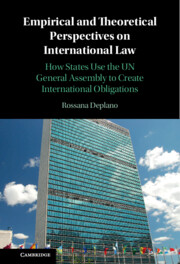
- Cited by 2
-
Cited byCrossref Citations
This Book has been cited by the following publications. This list is generated based on data provided by Crossref.
Mujuzi, Jamil Ddamulira 2024. The Protection of Seychelles’ Exclusive Economic Zone Through Penal Law: Analysing Warnakulusuriya Fernando v Republic [2000] and Kanapathi v R [2022] in the Light of Article 73(3) of United Nations Convention on the Law of the Sea. South African Yearbook of International Law, Vol. 49, Issue. ,
Mesquita, Rafael and Pires, Antonio 2024. Jurisprudence in hard and soft law output of international organizations: a network analysis of the use of precedent in UN Security Council and general assembly resolutions. Artificial Intelligence and Law,
- Publisher:
- Cambridge University Press
- Online publication date:
- July 2022
- Print publication year:
- 2022
- Online ISBN:
- 9781108678698


